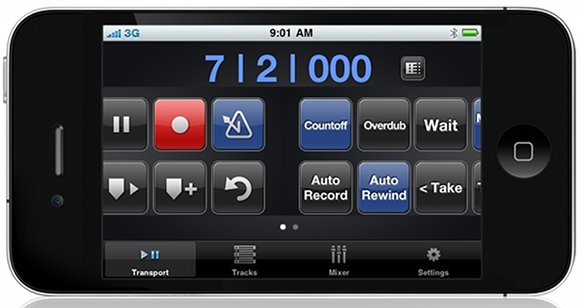
First-party touch control is gradually coming to big-name DAWs. There are plenty of third-party applications that allow control of music software, but until now, we’ve only seen Cubase iC from Steinberg for native control. Anyone who was betting Apple would be first for GarageBand or Logic, guess again – following Cubase over one year earlier, MOTU Digital Performer now comes with bi-directional mixing, transport, and editing features. (This should come as little surprise after MOTU added native OpenSoundControl support to their flagship Digital Audio Workstation.)
Correction: In the original version of this story, I suggested that MOTU DP Control was the “first” first-party app to offer native iOS touch control support, which is patently wrong. Steinberg’s Cubase iC absolutely deserves that honor, as noted by Chris Randall. I apologize for the mistake – it illustrates that, in over a year, no one other than Steinberg has entered this area, satisfied to leave it to third-party developers. MOTU does deserve to be the first major commercial DAW with OSC control, however, meaning one difference between the Cubase implementation and DP implementation is the fact that it’s accessible from any hardware or software that uses OSC. (Previously, that was true only of the open source DAW Ardour.)
In a wisely generous gesture, MOTU has released the control app for free for customers of DP 7.2 and up (as is Cubase iC also free, incidentally).
The app looks quite nice. I doubt that it’ll fully replace motorized control surfaces, but it doesn’t have to – even if you own such a control surface, having a handheld additional controller can be quite convenient.
DP users have expressed a desire to control more than the current OSC API allows, so I expect they’ll be vocal about what should be in a future release of this app. In the meantime, though, there’s access to quite a lot of the functionality you need. From MOTU’s feature list:
- Real two-way communication: changes made in DP Control are immediately reflected in DP, and vice versa.
- Editable time counter with selectable format (including real-time, SMPTE time, samples, and marker names).
- Main transport control and many other transport-related Control Panel functions (click, countoff, memory-cycle, etc.)
- Page-controlled, scrollable mixer with animated, recordable pan knobs and volume sliders, plus level meters and peak indicators.
- Solo, Mute, Record-enable, Play automation, Record automation and automation mode settings for each track.
- Track list for the host DP project, complete with collapsable nested track folders and dynamically linked track organization that matches the currently open DP project on the host Mac.
- Infinite undo, with the ability to step through the next and previous tasks in the host DP project undo history.
- Marker creation and naming.
- New Take, Previous Take, and Next Take functions that operate on all of the record-enabled tracks at once (essential for tracking drums).
- Take selection, by name, for individual tracks. Also New Take, Delete Take, and Rename Take for the current take on any individual track.
- Save function for saving changes made to the DP document.
Full details:
DP Control App
Of course, it’s one thing to read about software on paper. DP users, let us know how this works in practice, especially since you’ll be able to grab it for free if you own an iPod touch, iPad, or iPhone.
